人教版小学英语六年级上册知识清单(全)
六上U1-U3知识清单
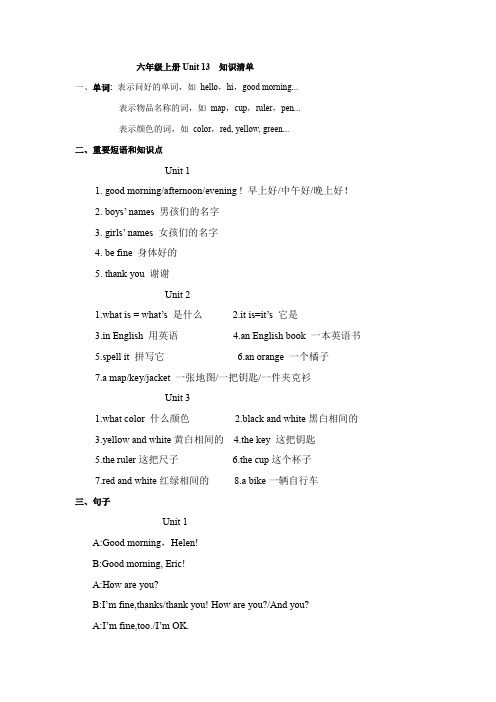
六年级上册Unit 13 知识清单一、单词: 表示问好的单词,如hello,hi,good morning...表示物品名称的词,如map,cup,ruler,pen...表示颜色的词,如color,red, yellow, green...二、重要短语和知识点Unit 11. good morning/afternoon/evening ! 早上好/中午好/晚上好!2. boys’ names 男孩们的名字3. girls’ names 女孩们的名字4. be fine 身体好的5. thank you 谢谢Unit 21.what is = what’s 是什么2.it is=it’s 它是3.in English 用英语4.an English book 一本英语书5.spell it 拼写它6.an orange 一个橘子7.a map/key/jacket 一张地图/一把钥匙/一件夹克衫Unit 31.what color 什么颜色2.black and white黑白相间的3.yellow and white黄白相间的4.the key 这把钥匙5.the ruler这把尺子6.the cup这个杯子7.red and white红绿相间的8.a bike一辆自行车三、句子Unit 1A:Good morning,Helen!B:Good morning, Eric!A:How are you?B:I’m fine,thanks/thank you! How are you?/And you?A:I’m fine,too./I’m OK.A:早上好,海伦!B:早上好,埃里克!A:你好吗?B:我很好,谢谢。
你呢A:我也很好。
Unit 2A:What’s this in English?B:It’s a jacket.A:What’s that in English?B:It’s an orange.A:Spell it,please.B:ORANGE.A:这个用英语怎么说?B:它是一件夹克衫。
六年级上册英语人教版重点知识
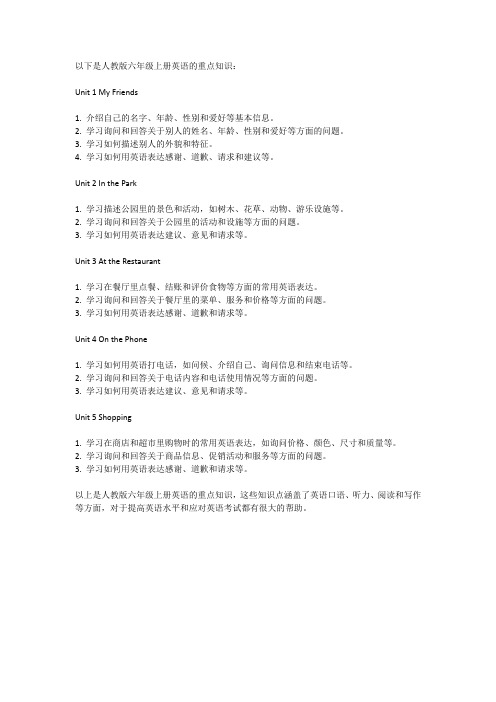
以下是人教版六年级上册英语的重点知识:
Unit 1 My Friends
1. 介绍自己的名字、年龄、性别和爱好等基本信息。
2. 学习询问和回答关于别人的姓名、年龄、性别和爱好等方面的问题。
3. 学习如何描述别人的外貌和特征。
4. 学习如何用英语表达感谢、道歉、请求和建议等。
Unit 2 In the Park
1. 学习描述公园里的景色和活动,如树木、花草、动物、游乐设施等。
2. 学习询问和回答关于公园里的活动和设施等方面的问题。
3. 学习如何用英语表达建议、意见和请求等。
Unit 3 At the Restaurant
1. 学习在餐厅里点餐、结账和评价食物等方面的常用英语表达。
2. 学习询问和回答关于餐厅里的菜单、服务和价格等方面的问题。
3. 学习如何用英语表达感谢、道歉和请求等。
Unit 4 On the Phone
1. 学习如何用英语打电话,如问候、介绍自己、询问信息和结束电话等。
2. 学习询问和回答关于电话内容和电话使用情况等方面的问题。
3. 学习如何用英语表达建议、意见和请求等。
Unit 5 Shopping
1. 学习在商店和超市里购物时的常用英语表达,如询问价格、颜色、尺寸和质量等。
2. 学习询问和回答关于商品信息、促销活动和服务等方面的问题。
3. 学习如何用英语表达感谢、道歉和请求等。
以上是人教版六年级上册英语的重点知识,这些知识点涵盖了英语口语、听力、阅读和写作等方面,对于提高英语水平和应对英语考试都有很大的帮助。
完整版)人教版六年级英语上册知识点汇总总结提纲
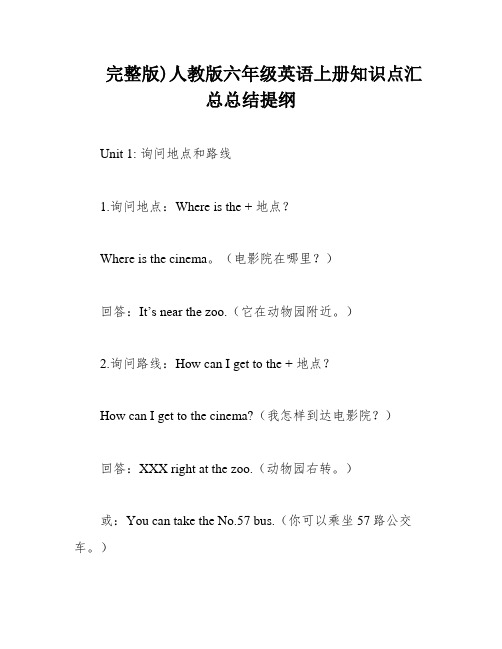
完整版)人教版六年级英语上册知识点汇总总结提纲Unit 1: 询问地点和路线1.询问地点:Where is the + 地点?Where is the cinema。
(电影院在哪里?)回答:It’s near the zoo.(它在动物园附近。
)2.询问路线:How can I get to the + 地点?How can I get to the cinema?(我怎样到达电影院?)回答:XXX right at the zoo.(动物园右转。
)或:You can take the No.57 bus.(你可以乘坐57路公交车。
)Unit 2: 交通方式1.询问某人怎样去某地:How do某人go(come) to + 地点?How do you go to school?(你怎么去学校?)回答:I go to school on foot.(我走路去学校。
)2.规定某人必须做某事:某人 + must + 动词原形XXX.(骑自行车的人必须戴头盔。
)I must pay n to the traffic XXX.(我必须注意交通信号灯。
)Unit 3: 打算做某事某人 + be going to + do(动词原形)She is going to see a film.(她打算去看电影。
)My uncle is planningXXX to go to the supermarket。
In this unit。
there are several types of ns that we can use to XXX。
For example。
we can ask "What are you going to do (+time or place)?" or "When are you going (+place)?" to get an XXX may include phrases such as "I am going to the cinema tomorrow" or "They are going to Nanjing next week."Similarly。
人教版六年级上册英语知识点汇总
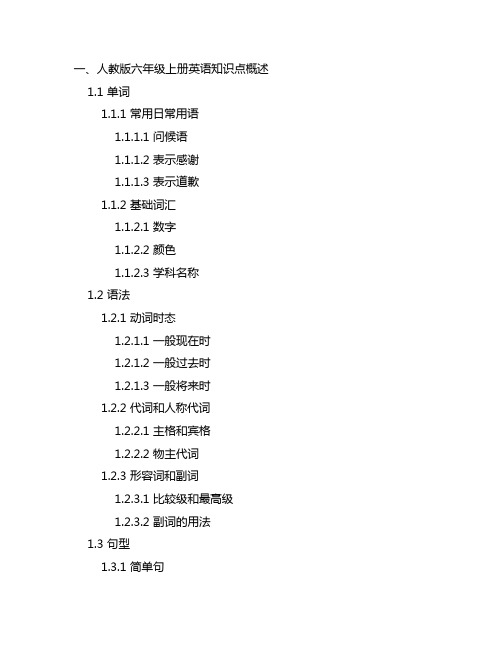
一、人教版六年级上册英语知识点概述1.1 单词1.1.1 常用日常用语1.1.1.1 问候语1.1.1.2 表示感谢1.1.1.3 表示道歉1.1.2 基础词汇1.1.2.1 数字1.1.2.2 颜色1.1.2.3 学科名称1.2 语法1.2.1 动词时态1.2.1.1 一般现在时1.2.1.2 一般过去时1.2.1.3 一般将来时1.2.2 代词和人称代词1.2.2.1 主格和宾格1.2.2.2 物主代词1.2.3 形容词和副词1.2.3.1 比较级和最高级1.2.3.2 副词的用法1.3 句型1.3.1 简单句1.3.1.1 肯定句1.3.1.2 否定句1.3.1.3 疑问句1.3.2 复合句1.3.2.1 并列句1.3.2.2 定语从句1.3.2.3 状语从句二、人教版六年级上册英语知识点详解2.1 单词2.1.1 常用日常用语2.1.1.1 问候语问候语是指在英语日常交际中用于打招呼和示好的常用词汇,包括Hello、Hi、Good morning、Good afternoon等等。
2.1.1.2 表示感谢表示感谢的常用词汇有Thank you、Thanks a lot、Thank you very much等,用于表达对别人的帮助或礼物表示感激之情。
2.1.1.3 表示道歉表示道歉的词汇包括I'm sorry、Excuse me、Pardon等,在日常生活中,用于向别人道歉或请求对方让步的场合。
2.1.2 基础词汇2.1.2.1 数字数字是英语基础词汇的重要部分,包括基本的数字表达方式和计量单位,如one、two、three等,以及hundred、thousand等。
2.1.2.2 颜色颜色是描述事物外观的重要词汇,在日常交流中也经常用到,包括red、blue、yellow等常见颜色词汇。
2.1.2.3 学科名称学科名称涉及到人们日常生活和学习工作的方方面面,包括mathematics、music、art等,是学习英语时必须掌握的词汇。
小学英语六年级上册知识清单

Unit 1 Growing up 一、我要掌握的词汇1.month一个月的时间;月份2.cute 可爱的3.pretty 漂亮的4.handsome英俊的;帅气的5.catch逮住;捕捉6.turtle 乌龟7.fly 苍蝇(flies 复数)8.grow up长大;成长9.junior high school 初级中学10.(be)born 出生11.primary school student小学生二、我要掌握的句型Her hair was short and her eyes were big.她的头发很短,她的眼睛很大。
拓展: (单数) is--was (复数)are--were1.He/She is...他/她是(一般现在)2.He/She will be...他/她将是··(一般将来)三、考点突破Her hair was short and her eyes were big.她的头发很短,她的眼睛很大。
(一般过去)解析:这是描写人物过去体貌特征的句型。
其句型结构为“主语+was/were++形容词.”。
当主语是I或第三人称单数时,be动词用was;其他情况 be动词用were。
例句:Mum,look at this photo. My hair was short then.妈妈,看这张照片。
那时我的头发很短。
四、如何写人物成长变化的小作文(一)、思维步骤1.确定时态。
此类短文是对比人物成长过程的变化,要用到两种时态:一般过去时和一般现在时。
2.我们在写的时候先选择一个小时候的片段用一般过去时来描述,然后用一般现在时介绍现在的情况,把两个不同的阶段进行对比。
(二)、精彩词句(三)、经典范文I was a cute boy when I was five years old. My hair was short and my eyes were big. I had a lot of toys. I also liked watching cartoons on TV. But now I am 11. I am tall now. I like playing football.I don't like to watch so many cartoons on TV. I like drawing cartoons now.当我5岁的时候我曾是个可爱的男孩。
人教版六年级英语上册各单元知识点汇总
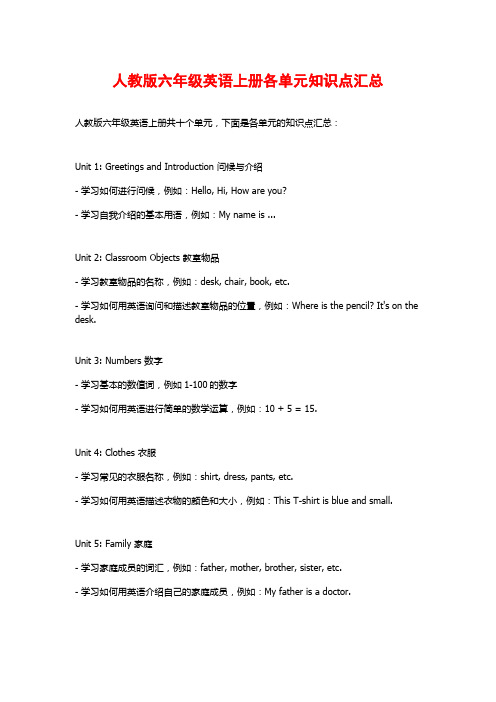
人教版六年级英语上册各单元知识点汇总人教版六年级英语上册共十个单元,下面是各单元的知识点汇总:Unit 1: Greetings and Introduction 问候与介绍- 学习如何进行问候,例如:Hello, Hi, How are you?- 学习自我介绍的基本用语,例如:My name is ...Unit 2: Classroom Objects 教室物品- 学习教室物品的名称,例如:desk, chair, book, etc.- 学习如何用英语询问和描述教室物品的位置,例如:Where is the pencil? It's on the desk.Unit 3: Numbers 数字- 学习基本的数值词,例如1-100的数字- 学习如何用英语进行简单的数学运算,例如:10 + 5 = 15.Unit 4: Clothes 衣服- 学习常见的衣服名称,例如:shirt, dress, pants, etc.- 学习如何用英语描述衣物的颜色和大小,例如:This T-shirt is blue and small.Unit 5: Family 家庭- 学习家庭成员的词汇,例如:father, mother, brother, sister, etc.- 学习如何用英语介绍自己的家庭成员,例如:My father is a doctor.Unit 6: Food 食物- 学习常见的食物名称,例如:apple, banana, bread, etc.- 学习如何用英语描述食物的味道和口感,例如:This banana is sweet and tasty.Unit 7: School Life 学校生活- 学习学校生活的用语,例如:go to school, have classes, play games, etc.- 学习如何用英语描述学校生活的常见活动,例如:I have English class at 9 o'clock.Unit 8: Hobbies and Free Time 爱好和业余时间- 学习常见的爱好词汇,例如:sing, dance, swim, etc.- 学习如何用英语询问和回答关于业余时间的问题,例如:What do you do in your free time? I like playing basketball.Unit 9: Daily Routine 日常生活- 学习描述日常活动的词汇,例如:get up, have breakfast, go to bed, etc.- 学习如何用英语描述自己的日常作息安排,例如:I get up at 7 o'clock in the morning.Unit 10: Travel and Places 旅行和地方- 学习关于旅行和地方的基本词汇,例如:train, bus, hotel, etc.- 学习如何用英语询问和指路,例如:Excuse me, how can I get to the post office? 希望对你有帮助!。
人教版六年级英语上册各单元知识点总结-六年级上册知识清单
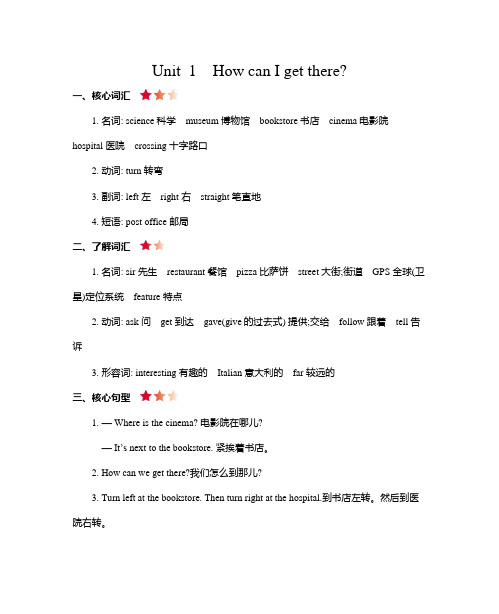
Unit 1How can I get there?一、核心词汇1. 名词: science 科学museum 博物馆bookstore 书店cinema 电影院hospital 医院crossing 十字路口2. 动词: turn 转弯3. 副词: left 左right 右straight 笔直地4. 短语: post office 邮局二、了解词汇1. 名词: sir 先生restaurant 餐馆pizza 比萨饼street 大街;街道GPS 全球(卫星)定位系统feature 特点2. 动词: ask 问get 到达gave(give的过去式) 提供;交给follow 跟着tell 告诉3. 形容词: interesting 有趣的Italian 意大利的far 较远的三、核心句型1. — Where is the cinema? 电影院在哪儿?—It’s next to the bookstore. 紧挨着书店。
2. How can we get there?我们怎么到那儿?3. Turn left at the bookstore. Then turn right at the hospital.到书店左转。
然后到医院右转。
注意:要注意介词的固定搭配。
Turn left/right at the …到……左/右转。
Get off at the …在……下车。
It’s on the left/right.在左/右边。
Walk/Go straight for … minutes.步行/直走……分钟。
It’s east/west/south/north of the …在……东/西/南/北边。
It’s far from the …距离……远。
四、了解句型1. Is there a …? ……有……吗?拓展: there be句型(1)主要用以表达“某处(某时)有某人(某物)”,其基本句型为“There+be 动词+名词+介词短语+其他.”There is a football under the chair. 椅子下面有一个足球。
人教PEP六年级上册全册知识清单
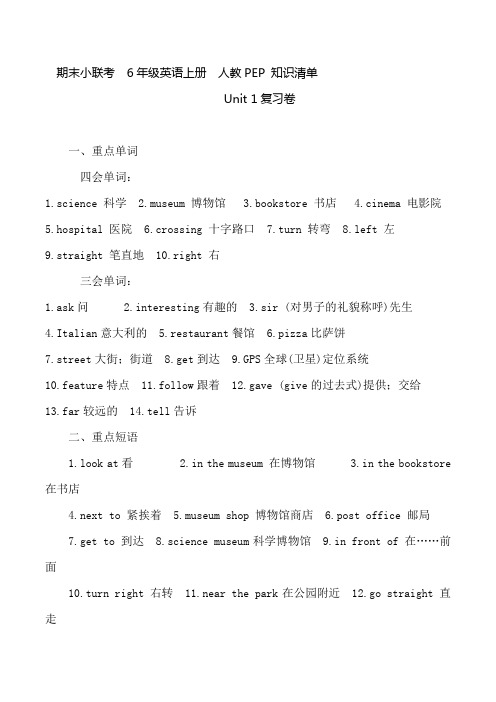
期末小联考6年级英语上册人教PEP 知识清单Unit 1复习卷一、重点单词四会单词:1.science 科学2.museum 博物馆3.bookstore 书店4.cinema 电影院5.hospital 医院6.crossing 十字路口7.turn 转弯8.left 左9.straight 笔直地 10.right 右三会单词:1.ask问2.interesting有趣的3.sir (对男子的礼貌称呼)先生4.Italian意大利的5.restaurant餐馆6.pizza比萨饼7.street大街;街道 8.get到达 9.GPS全球(卫星)定位系统10.feature特点 11.follow跟着 12.gave (give的过去式)提供;交给13.far较远的 14.tell告诉二、重点短语1.look at看2.in the museum 在博物馆3.in the bookstore 在书店4.next to 紧挨着5.museum shop 博物馆商店6.post office 邮局7.get to 到达 8.science museum科学博物馆 9.in front of 在……前面10.turn right 右转 11.near the park在公园附近 12.go straight 直走13.turn left 左转 14.a pet hospital一家宠物医院 15.a tour guide 一名导游16.pass by 经过 17.the Palace Museum 故宫博物馆三、重点句型1. —Where is the science museum?科学博物馆在哪儿?—It's near the library. 它在图书馆附近。
2.I want to buy a postcard. 我想买一张明信片。
3.There is a pet hospital in my city. 在我的城市里有一家宠物医院。
完整版)人教版六年级英语上册各单元知识点汇总
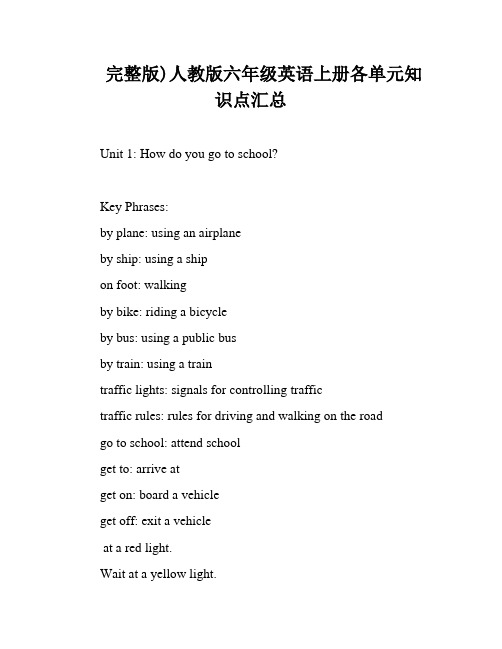
完整版)人教版六年级英语上册各单元知识点汇总Unit 1: How do you go to school?Key Phrases:by plane: using an airplaneby ship: using a shipon foot: walkingby bike: riding a bicycleby bus: using a public busby train: using a traintraffic lights: signals for controlling traffictraffic rules: rules for driving and walking on the roadgo to school: attend schoolget to: arrive atget on: board a vehicleget off: exit a vehicleat a red light.Wait at a yellow light.Go at a green light.Key Sentences:1.How do you go to school?ually。
I go to school on foot。
Sometimes。
I go by bus.3.How can I get to Zhongshan Park?4.You can take the No。
15 bus.Key Grammar:1.There are many ways to go somewhere。
"Ways" must be plural because "There are" is the plural form of the "There be" structure.2.For most n methods。
"by" is used。
(完整版)人教版(PEP)小学英语六年级上册复习资料
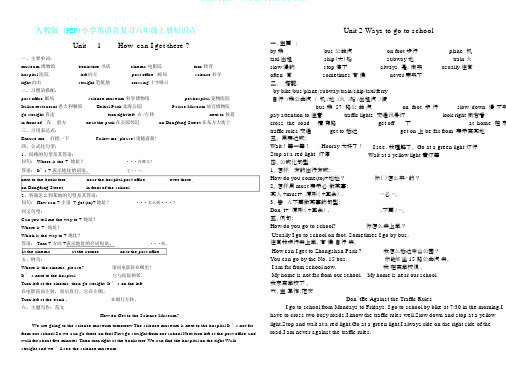
人教版 (PEP)小学英语总复习六年级上册知识点Unit1How can I get there ?一、主要单词:museum 博物馆bookstore 书店cinema 电影院turn 转弯hospital 医院left 向左post office邮局science 科学right 向右straight 笔挺地crossing 十字路口二、习惯语搭配:post office 邮局science museum 科学博物馆pet hospital 宠物医院Italian restaurant 意大利餐馆Beihai Park 北海公园Palace Museum 故宫博物院go straight 直走turn right/left 右 /左转next to 挨着in front of... 在 ...前方near the park 在公园邻近on Dongfang Street 在东方大街上三、习用表达式:Unit 2 Ways to go to school一、主要:by 乘bus 公共汽on foot 步行plane 机taxi 出租ship(大)船subway 地train 火slow 慢的stop 停下always 是,向来usually 往常often 常sometimes 有候never 素来不二、搭配:by bike/bus/plane/subway/train/ship/taxi/ferry自行 /乘公共汽 / 机 /地 /火 /船 /出租汽 /渡bus 乘 57 路公共汽on foot 步行slow down 慢下来pay attention to 注意traffic lights 交通讯号灯look right 向右看cross the road横穿路get off下at home 在家traffic rules 交通get to 抵达get on 上be far from⋯表示离某地Excuse me打搅一下Follow me, please! 请随着我!四、公式化句型:1、问路的句型及其答语:问句: Where is the + 地址?···在哪儿?答语: It’s + 表示地址的词语。
人教版小学英语六年级上册知识清单(全)

人教版小学英语六年级上册知识清单(全)小学英语六年级(上)单元必备知识清单Unit1 How Do You Go There?一、重点单词及短语:by经......,乘...... / foot脚(复数feet)/bike自行车/ bus公共汽车/train火车/plane飞机/ship轮船/subway地铁/how怎样,如何/go to school去上学/then然后/traffic交通/traffic light交通灯/traffic rule交通规则/stop停/wait等/get to到达/country国家(复:countries)drive驾驶/England英国/Australia澳大利亚/if如果/must必须/know知道※频度副词:always总是(100%)>usually通常(80%)>often通常(60%)>sometimes 有时候(40%)>hardly ever几乎不(20%)>never决不,从不(0%)※同音异义词:1.by经......,乘....../ buy购买/bye再见2.know知道/no不※反义词:different不同的—same相同的right右边的—left左边的二、重点句型:1、How do you go to school,Sarah?你怎么去上学,萨拉?2、Usually I go to school on foot.=I usually go to school on foot.我通常走路去上学。
3、Sometimes I go(to school) by bike.起地 comic book漫画书 post card明信片 newspaper报纸 magazine杂志 dictionary字典(复:dictionaries) shoe store鞋店 fruit stand 水果摊 pet shop宠物商店 need需要 plant(名)植物;(动)种植 else 其他一、重点句型:1.What are you going to do on the weekend?周末你打算干什么?2.I’m going to visit my grandparents this weekend.我打算这周末去看望我的(外)祖父母。
六年级上册英语知识清单

六年级上册英语知识清单一、单词1. 动物类 (animals)cat 猫 dog 狗 pig 猪 duck 鸭 rabbit 兔子 horse 马 elephant 大象ant 蚂蚁 fish 鱼 bird 鸟 monkey 猴子 panda 熊猫 lion 狮子 tiger 老虎 fox 狐狸 squirrel 松鼠2. 颜色类 (colors)red 红 blue 蓝 green 绿 yellow 黄 white 白 black 黑 pink 粉红purple 紫 orange 橙 brown 棕3. 数字类 (numbers)one 一 two 二 three 三 four 四 five 五 six 六 seven 七 eight 八 nine 九ten 十4. 食物类 (food)rice 米饭 bread 面包 beef 牛肉 milk 牛奶 water 水 egg 鸡蛋 soup 汤cake 蛋糕 ice cream 冰淇淋 cookie 饼干 chips 薯条5. 家庭成员类 (family)father 爸爸 mother 妈妈 grandpa 爷爷 grandma 奶奶 uncle 叔叔aunt 阿姨 brother 哥哥/弟弟 sister 姐姐/妹妹6. 学习用品类 (school things)pen 钢笔 pencil 铅笔 pencil box 铅笔盒 ruler 尺子 book 书 bag 包7. 其他 (others)bed 床 sofa 沙发 table 台灯 chair 椅子 desk 书桌二、短语1. How are you? 你过得好吗?2. What’s your name? 你叫什么名字?3. My name’s … 我叫…4. Good morning! 早上好!5. Good afternoon! 下午好!6. Goodbye! 再见!7. Nice to meet you! 很高兴认识你!8. Let’s go to school! 我们一起去上学吧!9. Stand up, please! 请站起来!10. Open your book, please! 请打开你的书!。
(完整版)人教版六年级英语上册各单元知识点汇总
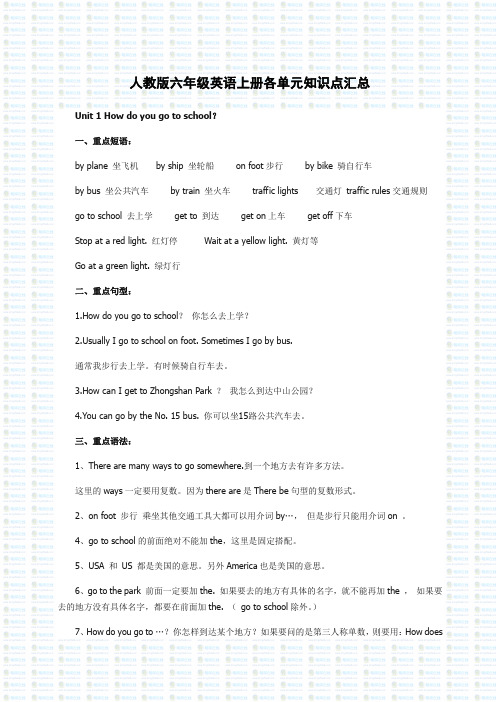
人教版六年级英语上册各单元知识点汇总Unit 1 How do you go to school?一、重点短语:by plane 坐飞机by ship 坐轮船on foot步行by bike 骑自行车by bus 坐公共汽车by train 坐火车traffic lights 交通灯traffic rules交通规则go to school 去上学get to 到达get on上车get off下车Stop at a red light. 红灯停Wait at a yellow light. 黄灯等Go at a green light. 绿灯行二、重点句型:1.How do you go to school?你怎么去上学?ually I go to school on foot. Sometimes I go by bus.通常我步行去上学。
有时候骑自行车去。
3.How can I get to Zhongshan Park ?我怎么到达中山公园?4.You can go by the No. 15 bus. 你可以坐15路公共汽车去。
三、重点语法:1、There are many ways to go somewhere.到一个地方去有许多方法。
这里的ways一定要用复数。
因为there are是There be句型的复数形式。
2、on foot 步行乘坐其他交通工具大都可以用介词by…,但是步行只能用介词on 。
4、go to school的前面绝对不能加the,这里是固定搭配。
5、USA 和US 都是美国的意思。
另外America也是美国的意思。
6、go to the park 前面一定要加the. 如果要去的地方有具体的名字,就不能再加the ,如果要去的地方没有具体名字,都要在前面加the. (go to school除外。
)7、How do you go to …?你怎样到达某个地方?如果要问的是第三人称单数,则要用:How doeshe/she…go to …?8、反义词:get on(上车)---get off(下车)near(近的)—far(远的)fast(快的)—slow(慢的)because(因为)—why(为什么)same(相同的)—different(不同的)9、近义词:see you---goodbye sure---certainly---of course10、频度副词:always 总是,一直usually 通常often经常sometimes 有时候never 从来不Unit 2 Where is the science museum?一、重点短语:library 图书馆post office 邮局hospital医院cinema 电影院bookstore书店science museum科学博物馆turn left向左转turn right 向右转go straight 直行north北south南east东west西next to靠近、与……。
(完整word版)人教版六年级上册英语知识点
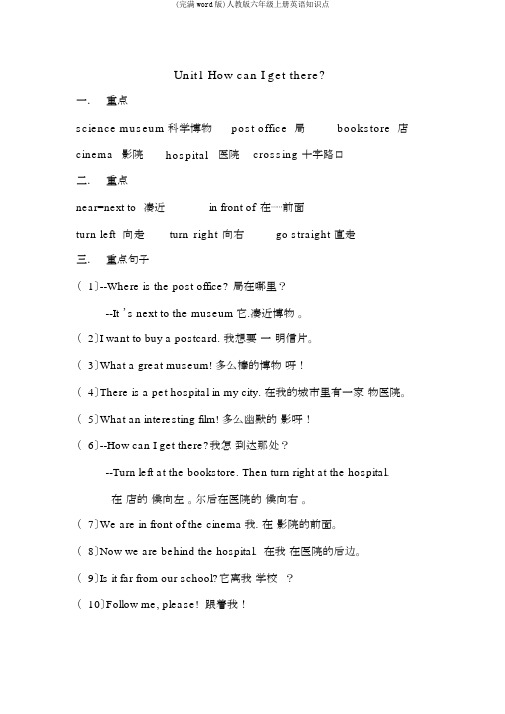
Unit1 How can I get there?一.重点science museum科学博物post office 局bookstore 店cinema影院hospital医院crossing 十字路口二.重点near=next to凑近in front of在⋯⋯前面turn left向走turn right向右go straight 直走三.重点句子(1〕--Where is the post office?局在哪里?--It ’s next to the museum它.凑近博物。
(2〕I want to buy a postcard. 我想要一明信片。
(3〕What a great museum! 多么棒的博物呀!(4〕There is a pet hospital in my city. 在我的城市里有一家物医院。
(5〕What an interesting film! 多么幽默的影呀!(6〕--How can I get there?我怎到达那处?--Turn left at the bookstore. Then turn right at the hospital.在店的候向左。
尔后在医院的候向右。
(7〕We are in front of the cinema我.在影院的前面。
(8〕Now we are behind the hospital. 在我在医院的后边。
(9〕Is it far from our school?它离我学校?(10〕Follow me, please! 跟着我!Unit2 Ways to go to school.一.重点词组walk=on foot步行by bus乘公共汽车by plane乘飞机by train乘火车by taxi乘出租车by ship 乘轮船by subway乘地铁slow down 减速二.重点句子(1〕--How do you come to school?你怎样来学校?--Usually I come on foot. Sometimes I come by bus.平时我步行上学。
人教版六年级上册英语重点知识点归纳
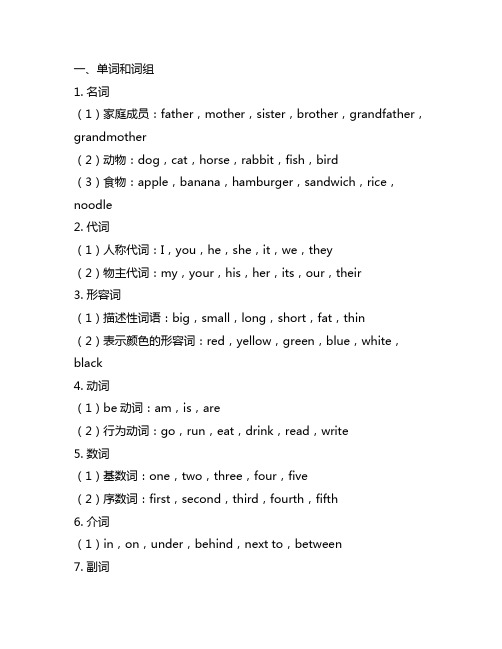
一、单词和词组1. 名词(1)家庭成员:father,mother,sister,brother,grandfather,grandmother(2)动物:dog,cat,horse,rabbit,fish,bird(3)食物:apple,banana,hamburger,sandwich,rice,noodle2. 代词(1)人称代词:I,you,he,she,it,we,they(2)物主代词:my,your,his,her,its,our,their3. 形容词(1)描述性词语:big,small,long,short,fat,thin(2)表示颜色的形容词:red,yellow,green,blue,white,black4. 动词(1)be动词:am,is,are(2)行为动词:go,run,eat,drink,read,write5. 数词(1)基数词:one,two,three,four,five(2)序数词:first,second,third,fourth,fifth6. 介词(1)in,on,under,behind,next to,between7. 副词(1)频度副词:always,usually,sometimes,never (2)程度副词:very,quite,too8. 连词(1)and,but,because9. 情态动词(1)can,could,may,might二、语法1. 一般现在时(1)肯定句形式:主语+动词原形+其他(2)否定句形式:主语+be动词+not+动词原形+其他(3)疑问句形式:Be动词+主语+动词原形+其他?2. 物主代词(1)第一人称单数:my(2)第二人称单数:your(3)第三人称单数:his,her,its(4)第一人称复数:our(5)第二人称复数:your(6)第三人称复数:their3. be动词(1)肯定句形式:主语+be动词+其他(2)否定句形式:主语+be动词+not+其他(3)疑问句形式:Be动词+主语+其他?4. 数词(1)基数词用法:表示数量,如one,two,three (2)序数词用法:表示顺序,如first,second,third 5. 介词短语(1)in/on/under+名词:表示位置(2)behind/next to/between+名词:表示位置关系三、对话1. 问候与介绍(1)Hello,I’m…(2)What’s your name?(3)How are you?2. 家庭成员介绍(1)This is my father/mother/sister/brother. (2)Is she your mother?(3)Yes, she is.3. 动物和食物(1)Do you have a pet?(2)Yes, I have a cat/dog/…(3)What’s your f avorite food?(4)My favorite food is…四、阅读1. 短文阅读Mary is a girl. She has a big family. She has a father, a mother, a sister and a brother. They have a dog and a cat. Mary’s favorite food is hamburger. She likes playing with her pets.2. 阅读理解(1)根据短文内容判断正误。
最新人教精通版小学英语六年级上册单元知识点总结(全册)

Unit1Igotoschoolat8:00.一、核心词汇1.描述日常活动的词汇cleanthewindow擦窗户cleanthedoor擦门cleanthefloor擦地板2.描述三餐的词汇breakfast早餐lunch午餐dinner晚餐3.描述时间的词汇morning早晨afternoon下午evening晚上; 傍晚4.频率副词often时常; 常常5.其他walk走; 步行every每一个easy容易difficult困难二、拓展词组描述日常活动的词组getup起床havebreakfast吃早餐gotoschool去上学havelunch吃午饭gohome回家havedinner吃晚饭watchTV看电视gotobed睡觉cookbreakfast做早餐teachEnglish教英语takeawalk散步readstories读故事seeafilm看电影playthepiano弹钢琴三、核心句型1.Igetupat7:30inthemorning. 我早晨七点半起床。
解读:此句是一个陈述句, 用来描述我在某一时刻所做的事情。
举一反三:Igotoschoolat8:00inthemorning. 我早晨八点去上学。
2.Shedoesn’tgetupat6:30inthemorning.她不在上午六点半起床。
解读: 此句是一个否定句, 用来描述某人在某一时刻没有做的事情。
举一反三:Shedoesn’tgetupat6:40.她不在六点四十分起床。
3.— WhatdoyoudoonSaturdays? 你星期六做什么?— Ioftengoandseeafilmwithmyparents. 我经常和我的父母一起去看电影。
解读:这是用来询问对方某天做什么及其回答的句子。
举一反三:— Whatdoyoudoontheweekend? 你周末做什么?— Ioftendohomework. 我经常做作业。
53天天练人教版六年级上册英语知识清单

53天天练人教版六年级上册英语知识清单以下是《人教版六年级上册英语》的知识清单:1. Numbers 1-100(数字1-100)2. Greetings and introductions(问候和自我介绍)3. Classroom language(课堂用语)4. Days, months, and dates(天、月、日期)5. Weather(天气)6. Daily routines(日常安排)7. Hobbies and interests(爱好和兴趣)8. Sports and activities(运动和活动)9. Food and drinks(食物和饮料)10. Family members(家庭成员)11. Occupations(职业)12. Places in the community(社区中的地方)13. Directions(方向)14. Transportation(交通工具)15. Animals(动物)16. Body parts(身体部位)17. Clothes(衣服)18. Colors(颜色)19. School subjects(学科)20. Time(时间)21. Adjectives(形容词)22. Present simple tense(现在时态)23. Present continuous tense(现在进行时态)24. Past tense(过去时态)25. Comparative and superlative forms(比较级和最高级)26. Modals(情态动词)27. Prepositions of time and place(时间和地点介词)28. Wh-questions(疑问词)29. Imperatives(祈使句)30. Possessive pronouns(所有格代词)31. Plural forms(复数形式)32. Articles(冠词)33. Pronouns(代词)34. Verb to be(be动词)35. Verb to have(have动词)36. Future tense(将来时态)以上是《人教版六年级上册英语》的知识清单,包括词汇、语法和语言功能等方面的内容。
人教版六年级英语上
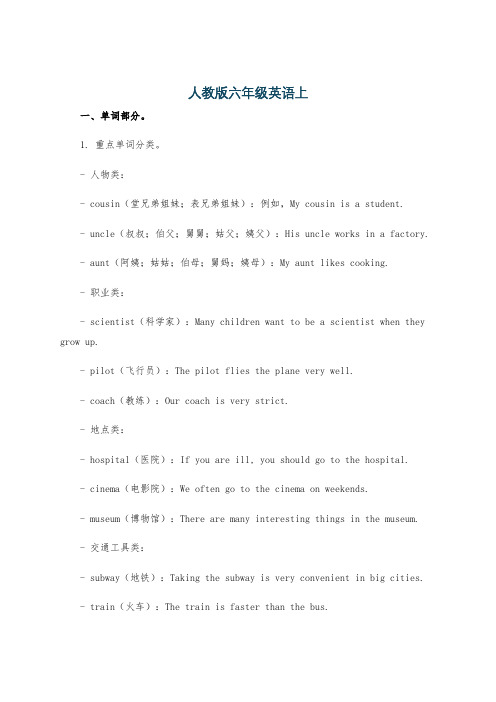
人教版六年级英语上一、单词部分。
1. 重点单词分类。
- 人物类:- cousin(堂兄弟姐妹;表兄弟姐妹):例如,My cousin is a student.- uncle(叔叔;伯父;舅舅;姑父;姨父):His uncle works in a factory.- aunt(阿姨;姑姑;伯母;舅妈;姨母):My aunt likes cooking.- 职业类:- scientist(科学家):Many children want to be a scientist when they grow up.- pilot(飞行员):The pilot flies the plane very well.- coach(教练):Our coach is very strict.- 地点类:- hospital(医院):If you are ill, you should go to the hospital.- cinema(电影院):We often go to the cinema on weekends.- museum(博物馆):There are many interesting things in the museum.- 交通工具类:- subway(地铁):Taking the subway is very convenient in big cities.- train(火车):The train is faster than the bus.- plane(飞机):We can go to other countries by plane.2. 单词记忆方法。
- 联想法:- 对于“hospital”这个单词,可以联想医院里有很多病人(patients),医生(doctors)和护士(nurses)在忙碌地工作,这样就容易记住这个单词的含义。
- 词根词缀法:- “scientist”这个单词,“science”表示“科学”,加上“ -ist”这个表示“人”的后缀,就变成了“科学家”。
人教版六年级上册英语知识点

人教版六年级上册英语知识点人教版六年级上册英语知识点概述一、词汇与短语1. 学校相关词汇- 教室(classroom)- 图书馆(library)- 操场(playground)- 办公室(office)- 食堂(canteen)2. 日常活动- 做作业(do homework)- 看书(read books)- 玩游戏(play games)- 听音乐(listen to music)- 做家务(do chores)3. 常见动物- 狗(dog)- 猫(cat)- 鸟(bird)- 鱼(fish)- 兔子(rabbit)4. 食物与饮料- 水果(fruit)- 蔬菜(vegetables)- 米饭(rice)- 面条(noodles)- 牛奶(milk)5. 家庭成员- 父亲(father)- 母亲(mother)- 兄弟(brother)- 姐妹(sister)- 祖父(grandfather)- 祖母(grandmother)二、语法要点1. 一般现在时- 描述经常发生的动作或状态。
- 使用动词原形,第三人称单数时动词加-s。
2. 一般过去时- 描述过去发生的动作或状态。
- 规则动词加-ed,不规则动词需记忆其过去式形式。
3. 现在进行时- 描述正在进行的动作。
- 结构为be动词(am/is/are)+ 动词-ing形式。
4. 可数名词与不可数名词- 可数名词有单数和复数形式,不可数名词通常没有复数形式。
5. 代词- 主格代词(I, you, he, she, it, we, they)- 宾格代词(me, you, him, her, it, us, them)- 形容词性物主代词(my, your, his, her, its, our, their)- 名词性物主代词(mine, yours, his, hers, its, ours,theirs)三、句型结构1. 简单句- 陈述句:表达事实或状态。
- 1、下载文档前请自行甄别文档内容的完整性,平台不提供额外的编辑、内容补充、找答案等附加服务。
- 2、"仅部分预览"的文档,不可在线预览部分如存在完整性等问题,可反馈申请退款(可完整预览的文档不适用该条件!)。
- 3、如文档侵犯您的权益,请联系客服反馈,我们会尽快为您处理(人工客服工作时间:9:00-18:30)。
小学英语六年级(上)单元必备知识清单Unit1 How Do You Go There?一、重点单词及短语:by经......,乘...... / foot脚(复数feet)/bike自行车/ bus公共汽车/train火车/plane飞机/ship轮船/subway地铁/how怎样,如何/go to school去上学/then然后/traffic交通/traffic light交通灯/traffic rule交通规则/stop停/wait等/get to到达/country国家(复:countries)drive驾驶/England英国/Australia澳大利亚/if如果/must 必须/know知道※频度副词:always总是(100%)>usually通常(80%)>often通常(60%)>sometimes 有时候(40%)>hardly ever几乎不(20%)>never决不,从不(0%)※同音异义词:1.by经......,乘....../ buy购买/bye再见2.know知道/no不※反义词:different不同的—same相同的right右边的—left左边的二、重点句型:1、How do you go to school,Sarah?你怎么去上学,萨拉?2、Usually I go to school on foot.=I usually go to school on foot.我通常走路去上学。
3、Sometimes I go(to school) by bike.=I sometimes go (to school)by bike.有时候我骑自行车去。
4、Stop at a red light.红灯停。
Wait at a yellow light.黄灯等。
Go at a green light.绿灯行。
5、How can I get to Zhongshan Park?我怎么能到达中山公园呢?6、You can go by the No.15 bus.=You can take the No.15 bus.你可以乘坐15路公共汽车去。
小学英语六年级(上)单元必备知识清单Unit2 Where Is the Science Museum?一、重点词汇:library图书馆 post office邮局 hospital医院 cinema电影院bookstore书店 science museum科学博物馆excuse me对不起 where 在哪里 please请 next to与......相邻 supermarket超市 bank银行shoe store鞋店 after school放学以后 want想要 a pair of 一双north北 south南 east东 west西 turn left左转 turn right右转 go straight直走 look for寻找 far from...离......远 near here这附近※同音词:where在哪里—wear穿※近义词:next to与......相邻—near在附近look for寻找(强调找的动作)—find(强调找的结果)※对应词(反义词):far远—near近 get off下车—get on上车 north北—south南east东— west西 turn left左转—turn right右转二、重点句型:1.Where is the cinema,please?请问,电影院在哪?2.It’s next to the hospital.它与医院相邻。
3.Turn left at the cinema,then go straight.在电影院处左转,然后直行。
4.It’s on the left.它在左边。
5.It’s east of the cinema.它在电影院的东边。
6.Walk west for three minutes.往西走三分钟。
三、语法重点:某处客观存在的“有”(就近原则)have (has)某人拥有小学英语六年级(上)单元必备知识清单Unit4 I Have a Pen Pal.一、重点词汇:hobby爱好(复:hobbies)/ride(riding)a bike骑自行车/ dive(diving)跳水/ play(playing) the violin拉小提琴/ make(making)kites制作风筝/collect(collecting) stamps集邮/pen pal笔友dear亲爱的(同音词:deer鹿)/fun快乐,乐趣(形:funny)/ with和....../ live(lives)居住/ teach(teaches)教/go(goes)去/watch(watches)看/read (reads)读/does(do的三单)→(否定)doesn’t=does not/say说/excited兴奋的(主语是人)二、重点句型:1.What’s your hobby?=What do you like?你有什么爱好?答语:I like...2. What’s her hobby?=What does she like?你有什么爱好?答语:She likes...3. What’s his hobby?=What does he like?你有什么爱好?答语:He likes...4.I like collecting stamps.我喜欢集邮。
5.He likes collecting stamps,too.他也喜欢集邮。
6.-Does she teach English?她教英语吗?-Yes,she does.是的,她教。
/No,she doesn’t.不,她不教。
三.2.一般现在时,动词第三人称变化规则口诀。
3.主语属于第三人称单数范围4.区别四个“看”:(1)read 阅读(看书、看报纸、看杂志)(2)watch观看(看电视、看比赛,强调看的过程)(3)look强调看的瞬间动作(4)see强调看的结果(看到)5.区别四个“说”:(1)say强调说的内容(2)speak强调说的方式,后常接语言。
如:speak in English用英语说(3)talk强调多人之间的交流、谈论,通常有问有答。
Let’s talk.(4)tell讲述(讲故事,讲笑话,撒谎等)tell stories讲故事6.含有实义动词的的句子(1)变一般疑问句及回答:Do/Does +主语+动词原形+其他?肯定回答:Yes,主语+do/does. 否定回答:No,主语+don’t/doesn’t.如:○1 -Does she teach you English?-Yes,she does./No,she doesn’t.○2-Do you like collecting stamps?-Yes,I do./No,I don’t.(2)变否定句:主语+don’t/doesn’t+实义动词原形+其他.注:○1some变any ○2“一”变”二”如:I have some English dictionaries.(变否定句)I don’t have any English dictionaries.He likes riding a bike. (变否定句)He doesn’t like riding a bike.小学英语六年级(上)单元必备知识清单Unit5 What Does She Do?一、重点词汇:singer歌唱家writer作家actor男演员actress女演员artist画家TV reporter电视台记者show表演HongKong香港engineer工程师accountant会计policeman(复:policemen)男警察policewoman(policewomen)女警察salesperson销售员cleaner清洁工company公司factory(factories) 工厂design设计(名词:designer设计师) help帮助 money金钱(不可数名词) well好地 enjoy从......获得乐趣 tourist旅行者motor cycle(motorbike)摩托车二、其他相关知识:(一)缩写:who’s=who is she’s=she is he’s=he is(二)对应词:he—she actor—actress uncle—aunt here—there (三)同音词:aunt—aren’t their—there write—right here—hear三、语法聚焦:1、询问职业的句型:What do/does+主语+do?=What +be动词(is,am,are)+主语?注:此句型不用于第二人称的询问,即:What are you?是错误的,应说:What do you do? 其他人称两种句型都可。
2. enjoy+ doing “热衷于做某事”名词“热衷某事(物)”3. 帮助某人做某事:(1)help sb.(to) do sth.(2)help sb. with sth.如:(1)She often helps tourists find their way.(2)Let me help you with your English.4.区别good和well两个“好”:(1)good“好的”是形容词,修饰名词,做定语。
如:a good book一本好书(2)well“好地”是副词,修饰动词。
如:study well学地好5. a和an 用法口诀:a和an 很像,两者用法不一样,辅音单数a 提前,元音单数an优先,代在名前来相伴,a和an都看不见。
如:a cleaner一名清洁工 an engineer 一名工程师6.重点句子必背:(1)What does your mother do? =What is your mother?(2)She is a TV reporter.(3)-Where does she work? -She works in a car company.(4)-How does she go to work? -She goes to work by bus.小学英语六年级(上)单元必备知识清单Unit6 The Story of Rain.一、重点词汇:rain雨;下雨 cloud云vapour水蒸气sun太阳stream(小)河;(小)溪come from来自于......seed种子soil土壤sprout嫩芽plant植物;种植should应该then然后,那么二、有关come的几个短语:e from(=be from)来自于......e.g. Where does she come from?=Where is she from?她来自哪儿?e out 露出;出现e on 加油e in进来三、其他相关知识:同音词:1.sun太阳—son儿子2.meet遇见—meat肉3.high高的—hi你好4.see看见—sea大海5.flower花—flour面粉反义词:old :(1)年老的—young年轻的(2)旧的—new新的四、几种“再见”的表达方式:1.Goodbye2.Bye-bye3.Bye4.See you.5.See you then.6.See you later.五、三个“许多”用法区分:1.many修饰可数名词复数。
